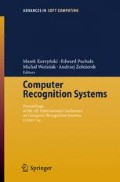Abstract
In the current study two various segmentation methods have been implemented sequentially in computer-aided approach to the assessment of skeletal maturity, where correct location of borders of anatomical structures is a crucial step. The first segmentation stage, based on the Gibbs random fields technique, correctly segments out a bony structure and roughly outlines the edges of cartilage while the second one using the active contour strategy, smoothes them and prepares for the feature extraction stage. A synthetic region of interest has been designed to test and adjust weights of the snake energy functional. These weights have afterwards been applied to a real image data. In comparison to our previous works we observe a significant improvement of boundary location mainly when cartilage is included in the epiphyses.
Access this chapter
Tax calculation will be finalised at checkout
Purchases are for personal use only
Preview
Unable to display preview. Download preview PDF.
References
Greulich WW, Pyle SI (1971) Radiographic Atlas of Skeletal Development of Hand Wrist. Stanford University Press, Stanford CA
Tanner JM, Whitehouse RH (1975) Assessment of Skeletal Maturity and Prediction of Adult Hight (TW2 Method). Academic Press, London
Pietka E, Gertych A, Pospiech S, Huang HK, Cao F (2001) Computer assisted bone age assessment: Image pre-processing and ROI extraction. IEEE Trans. on Medical Imaging 20:715–729
Pietka E, Pospiech S, Gertych A, Cao F, Huang HJ, Gilsanz V (2001) Computer Automated Approach to the extraction of epiphyseal regions in hand radiographs. Journal of Digital Imaging 14:165–172
Gertych A, Pietka E (2003) An automated segmentation and features extraction from hand radiographs. Archives of Theoretical and Applied Informatics 15 (workbook 3):315–326
Kass M, Witkin A, Terzopoulos D (1988) Snakes: Active Contour Models. International Journal of Computer Vision 321–331
Terzopoulos D, Fleisher K (1988) Deformable models. Visual Computer 4:306–331
Gonzales RC, Woods RE (1993) Digital Image Processing. Addison-Wesley, Reading MA
Williams DJ, Shah M (1992) A Fast Algorithm for Active Contours and Curvature Estimation. CVGIP: Image Understanding 55(1):14–26
Pietka E, Pospiech-Kurkowska S, Gertych A, Cao F (2003) Integration of Computer assisted bone age assessment with clinical PACS. Comp. Med. Img. Graph, 27(2–3):217–228
Author information
Authors and Affiliations
Editor information
Editors and Affiliations
Rights and permissions
Copyright information
© 2005 Springer-Verlag Berlin Heidelberg
About this paper
Cite this paper
Gertych, A., Pietka, E., Huang, H.K. (2005). Active Contour Technique in Post-segmentation Edge Smoothing Applied to Hand Radiograph Regions of Interest. In: Kurzyński, M., Puchała, E., Woźniak, M., żołnierek, A. (eds) Computer Recognition Systems. Advances in Soft Computing, vol 30. Springer, Berlin, Heidelberg. https://doi.org/10.1007/3-540-32390-2_60
Download citation
DOI: https://doi.org/10.1007/3-540-32390-2_60
Publisher Name: Springer, Berlin, Heidelberg
Print ISBN: 978-3-540-25054-8
Online ISBN: 978-3-540-32390-7
eBook Packages: EngineeringEngineering (R0)

